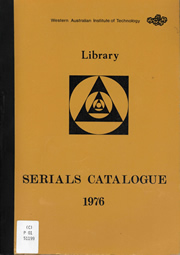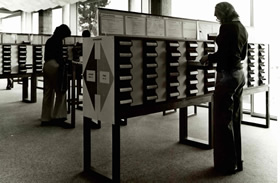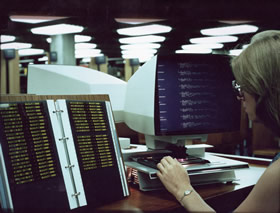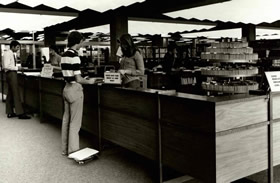
Automating library management systems
From the outset WAIT library was among the pioneers in the automation of library services.
Although there were many attempts around the world through the 1960s to automate library activities, successes were limited. There were almost no commercially available library automation packages, although in the United Kingdom, Automated Library Systems had developed basic loan systems. In general, systems were specific to particular libraries and particular computers. 19
To some extent failures to achieve viable automation in libraries were a consequence of over-reaching ambition to create one comprehensive system that would control all major library activities. At WAIT, Allen and staff in the systems section decided to adopt a piece-by-piece approach and to worry about integration of systems once individual processes had been successfully automated.
This approach paid off to the extent that in the late 1970s and early 1980s WAIT library was almost certainly one of the most automated libraries in the country. 20
The Library’s first success was the development of an automated acquisitions system which was implemented at the same time as staff were moving into Robertson Library in late 1971. It was a card based batch system and with several major rewrites, it had sufficient flexibility to survive into the late 1980s. The system allowed better control of ordering and expenditure processes and budget allocation.
In 1980, the Library brought in a new computerised ordering and accounting system for books and other non-journal resources. The new book and audiovisual resource ordering and accounting computer system allowed improved planning around collection development and the changing needs of academic courses through budgeting of committal funds by subject.
Automating the journal catalogue (the listing of serials, magazines, newspapers, etc.)
At this time, the journal catalogue was a printed listing of journal titles and holdings information (the years/volumes of each journal that the Library held). Keeping this printed listing up to date was a time consuming task for staff.
Introducing an automated cataloguing system for journals 21 was the next priority for the Library. In 1972, a shared catalogue 22 was created listing all journal titles and their associated holdings for Robertson Library and the three branch libraries at Shenton Park, Kalgoorlie and Muresk.
Three years on, in 1976, the first computer typeset printed journals catalogue was produced. This meant that the journal listing could be generated more efficiently and accurately and updated more frequently, a big improvement for clients wanting information about journals and holdings.
Because the journals cataloguing system functioned as a union catalogue, other tertiary libraries in Western Australia 23 subsequently contributed their journal records, leading to the creation of the Joint Serials catalogue which was printed annually from 1977 to 1984. 24
Automating the monograph catalogue (the listing of books, audiovisual items, posters and other non journal resources)
In the 1970s, the monograph catalogue was a card catalogue and the ongoing work of adding new titles and amending holdings information was such that at peak periods, staff spent well over 100 hours per week sorting and filing cards.
By the time serious work began on automating the monograph catalogue, the MARC (Machine Readable Cataloguing) format had been generally accepted by libraries and the WAIT data was encoded to this standard from the start. From 1972, all new acquisitions were entered onto a computer master file using MARC and the retrospective conversion of card catalogue records to computerised catalogue records began.
In 1976 some 30 000 MARC records were purchased in bulk from the National Library of Australia to speed up this retrospective conversion. 25
While work on the automation of the cataloguing of monographs continued 26, parallel processing for the card catalogues was sustained until 1980 and these catalogues remained the means by which clients searched for books and other non journal items.
The creation, in 1980, of a microfiche catalogue for the Library’s monograph collection was a major milestone. It provided author, title, subject and Dewey Decimal classification sequences on microfiche, was portable and could be distributed beyond the library walls. It was completely updated four times a year, with cumulated weekly supplements in the intervening periods.
While microfiche catalogues were of course being produced by other libraries at the time, the WAIT Library catalogue was probably unique in the internal format of the fiches (a continuous column arrangement) and was much easier to use 27.
The automated production of the catalogue brought many benefits, not least of which was the saving of staff time. For patrons, the major benefit was the much-improved access to the Library’s collections and the new catalogue was a major public success. The early imaginative promotion of the Fichecat, complete with colourful branding, and the trouble-free changeover period, ensured the reception from patrons was overwhelmingly positive. 28
Automating loans
An automated loan system had been identified as a priority in the 1970s and indeed, the design and specifications for such a system were completed in 1978.
The loans desk used a modified version of the Browne issue system 29 which involved date stamps and manual filing of borrower cards and book cards. By 1979, when over 141 000 loans were issued by WAIT Library, the system was in danger of collapse.
Library staff worked to develop the automated loans system with a team at Datec Computer Services which had been contracted to undertake the technical design and programming. Automated Library Systems (ALS) terminals were purchased.
In preparation for the implementation, the Library closed for four weeks and all Library staff assisted with the task of inserting ALS machine readable unique identifying labels into the roughly 160 000 loanable items in the collection. 30
The system went live in 1980 but problems soon emerged making a return to manual loans necessary for a semester. 31
Once critical issues were solved however, the automation of loans brought major efficiencies to loans desk tasks, allowed accurate loan records to be maintained, and made easier the processing of recalled materials and overdue items.
In addition, reports on borrowing patterns could be created to help inform collection and loan guidelines. The old manual loans system had provided only limited control of loans and little data on the use of the collection.
 Acquisitions staff at work on level two.
Acquisitions staff at work on level two.
The in-house automated order system accepted data on standard punched cards, produced orders printed on a computer line-printer and kept an ‘on-order’ file on magnetic discs. The accounting system was maintained on computer and provided regular budget reports as well as reports on outstanding orders and the performance of booksellers.
As a result, WAIT Accounts Department no longer needed to maintain ledgers for Library orders, saving some 11 000 individual ledger entries in 1971 alone.
 Cover of the Library's first computer typeset serials (journals) catalogue, 1976.
Cover of the Library's first computer typeset serials (journals) catalogue, 1976.
Using magnetic tape files generated on WAIT's computer, the catalogue was created and printed by Vallentines in Melbourne and bound by the Library bindery.
 Students using the card catalogues at Robertson Library, early 1970s.
Students using the card catalogues at Robertson Library, early 1970s.
Catalogue cards were filed in drawers by author, title and subject and provided a record of holdings of the Bentley campus and branch library collections. Branches had sub-sets of the catalogue for use on site.
View a catalogue card for a book on level two and an amended card for a book relocated to level six.
 Library staff sorting and updating catalogue cards.
Library staff sorting and updating catalogue cards.
Once the hundreds of card catalogue drawers containing hundreds of thousands of printed cards were no longer needed, staff gradually withdrew them over 1980 and the daily card filing became a thing of the past.
 The microfiche catalogue in use in the Library, early 1980s.
The microfiche catalogue in use in the Library, early 1980s.
The catalogue was accessible on 18 microfiche readers in Robertson Library and in each of the branch libraries. Microfiche catalogues were also distributed to WAIT academic departments, public libraries of regional centres, the National Library of Australia and the Western Australian State Bibliographical Centre.
 The loans desk on level three in the 1970s, before loans were automated.
The loans desk on level three in the 1970s, before loans were automated.